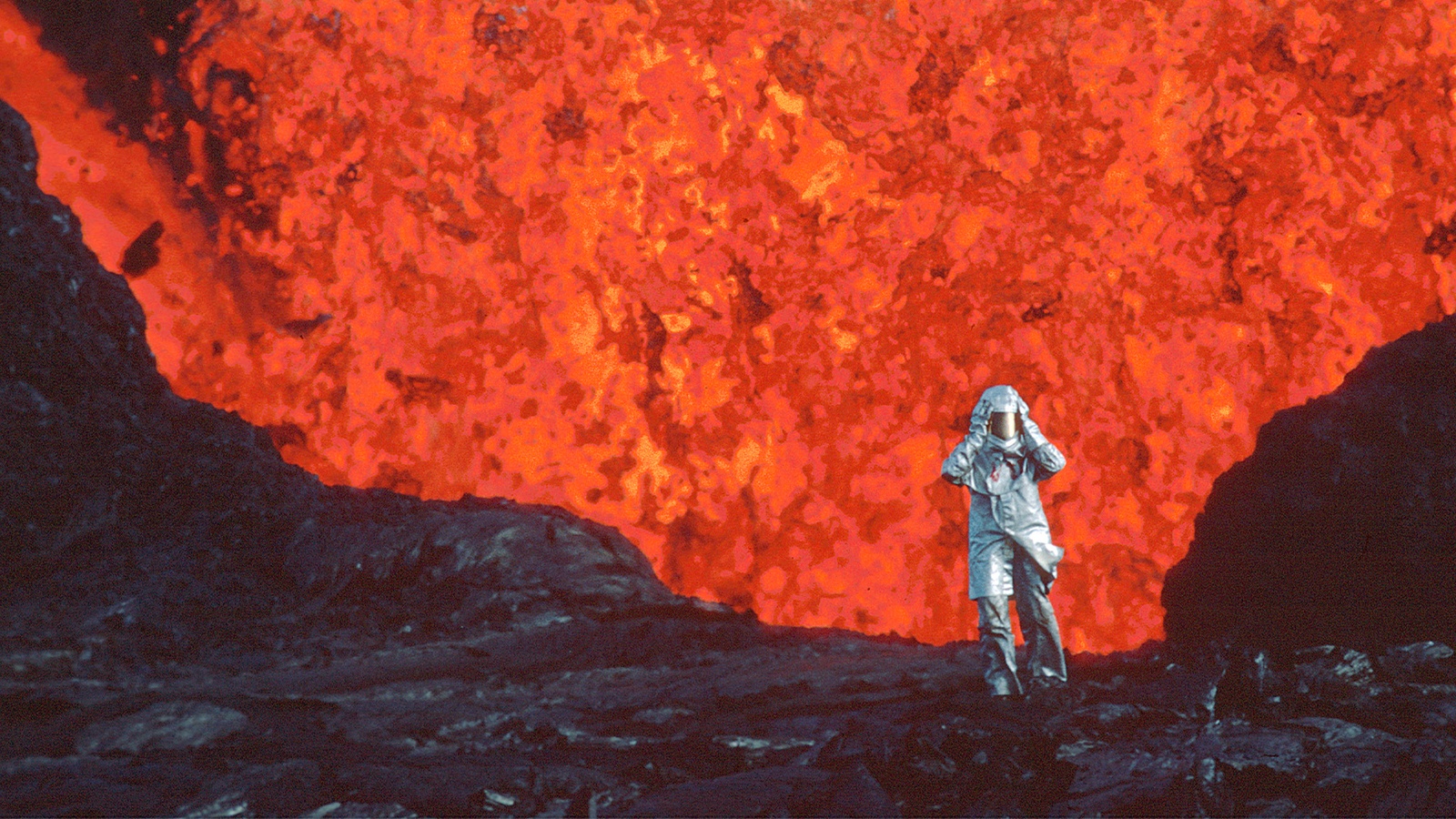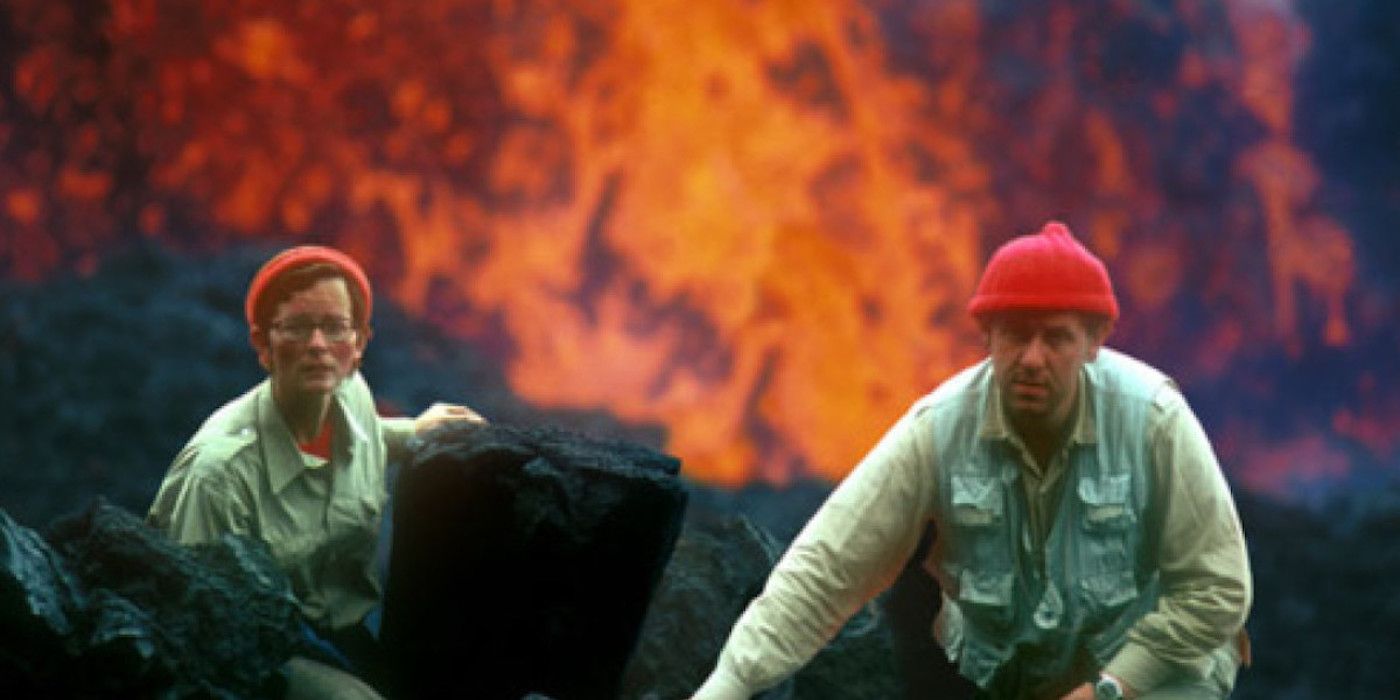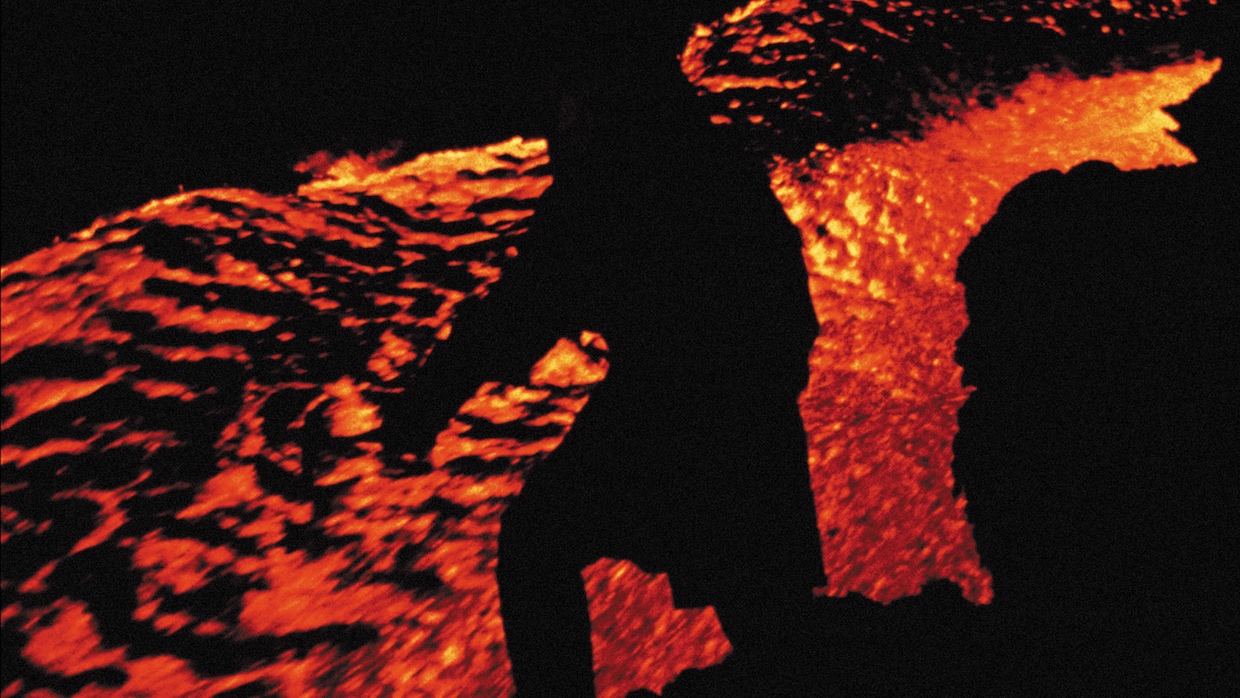For your reading pleasure, please enjoy our Oscar Lessons interview with director Sara Dosa about helming Fire of Love from Backstory Magazine’s issue 49 – now available to read! If you enjoy what you’ve read, we hope you’ll join us to read the rest of the issue by subscribing to Backstory Magazine!
Director Sara Dosa on the love story of volcanologists Maurice and Katia Krafft, who died in the field but left behind a massive legacy
By Danny Munso
Sara Dosa fell in love with the work of Katia and Maurice Krafft before she knew who they were. While researching volcanoes during production of the 2019 film The Seer & the Unseen—which is set in Iceland, an island created by volcanic eruptions—she and her team kept coming across the Krafft’s photos and research. That led to her wanting to discover more about the pioneering French volcanologists. “We found their images, and they were just spectacular,” Dosa says. “It made me think, Wow, the Earth looks like this—so surreal and beguiling? Then we learned were a couple and that they were absolutely obsessed with volcanoes, and we immediately thought, What a story. There’s a couple in love with each other and the Earth and they’ve committed their lives to do this.”
Dosa put that interest on the backburner in order to start another film digging into a series of mysterious methane explosions happening in Siberia. Her team was gearing up for their first scout that was to take place in April 2020, when the COVID pandemic hit and forced the project to the sidelines. “At the time, we were thinking, How can we keep making work?” she recalls. “For me personally, making films is what makes me feel connected to the planet and to people, so I wanted to keep working. I remembered the story of the Kraffts, and we had heard there was much more footage than what we had seen. So we began a research process and thought it could be an amazing project to do during this time of isolation.”
The resulting film—Fire of Love—became much more than that. After premiering at the 2022 Sundance Film Festival, the movie was picked up by National Geographic Films, played in Imax theaters all across the country, began streaming on Disney+ and became an awards-season darling, culminating in an Oscar nomination for Best Documentary Feature and Dosa being awarded the Directors Guild Award for Outstanding Directorial Achievement in Documentaries. Beyond that, the film has brought a renewed and deserved spotlight to the work of Katia and Maurice Krafft, who were married in 1970 and dedicated their lives to the perilous but important work of studying volcanoes, and it ultimately cost them their lives in 1991 after an eruption at Mount Unzen in Japan. Dosa remembers the feeling she got by being able to work on such a special project in the middle of the pandemic. “I felt so grateful to be transported throughout the world through the Kraffts’ imagery and to be met with their philosophy, which is all about finding meaning within the unknown and navigating uncertainty and fear. These were all things we were [also] experiencing during the pandemic. In my own life, I went through a pretty significant loss, so being met with guides through this who got me thinking about life and death and uncertainty was very meaningful. And I got to do that with my incredible collaborators, who are some of my closest friends in the world. It was like a big joyous group project.”

The director’s core team consisted of producer Shane Boris—a producer on her previous film—and the movie’s two editors, her longtime collaborator Erin Casper and Jocelyne Chaput. Dosa and the editors formed an especially unique working bond, as Chaput lives five minutes from Dosa in Berkeley, California, while the New York-based Casper moved into Dosa’s house for a few months while editing took place. Their first task was receiving the Kraffts’ entire archive, which was being held by Image’Est, a company in France that serves as a resource for filmmakers and promotes film conservation. The couple’s only living relative—Maurice’s brother Bertrand—approved Dosa’s access to the material, which included over 200 hours of 16mm film their team had shot as well as their writings and photographs. Image’Est would scan the film in 20-hour batches and send it across the world to Dosa via an FTP server. Dosa, Casper and Chaput would watch the footage together as each batch came in, and Dosa started cataloging the images in an Excel doc before abandoning that early on. “I was logging my notes, but I quickly realized I was only putting down, ‘This is incredible—we have to use this shot,’ for everything so it became kind of meaningless,” she laughs. It was down to Casper and Chaput to sort everything by year and location, which helped keep things straight. They also brought in an assistant editor—Victor Helwani—to chart each instance the Kraffts themselves appeared in the footage, either separate or together. Finally, archival producer Nancy Marcotte began tracking down every television appearance made by the couple that was in the public holdings of countries including their native France and other French-speaking locales.
These public appearances would turn out to be crucial to Dosa’s film for several reasons. First, the 16mm footage shot by the Kraffts had no sound, an obstacle the team would eventually have to tackle. But more important, their footage and personal archive in general was short on examples of the couple being, well, a couple—and Dosa had decided early on that Fire of Love would be, above anything else, a love story. “In one of his writings, there’s a sentence where Maurice says, ‘For me, Katia and volcanoes is a love story,’ ” Dosa says. “We felt like Maurice was giving us a prism through which to see the material they left behind. He’s saying it’s not just a love story between me and my wife. It’s a love triangle between Katia, me and the elemental force that are volcanoes. Using that as our primary guide, we were really tasked with how to communicate that love story.” Unfortunately, there are barely any personal photographs of the pair together, which is where the public appearances really paid off, as it showed how they interacted together and with others. But it still wasn’t enough to form the love story narrative Dosa desired. “They said wonderful things, but they definitely didn’t talk about their relationship very often, and there also wasn’t visual imagery that communicated romance. However, through our research it kept coming up that perhaps the love story was the truest interpretation of this vast legacy, and again that was something we really thought Katia and Maurice impressed upon us.” So early in the editing process, Dosa and the team decided the film needed a narrator.

The narration is not simply in Fire of Love to provide the viewer static facts and help move the plot along. Performed by writer-director-actor Miranda July, the narration becomes a character on its own, whimsically describing certain visuals while asking overarching rhetorical questions. Dosa and the others—the director, Boris, Casper and Chaput are all listed as co-writers—were inspired by the films of the French New Wave in crafting the film’s unique voiceover. “Part of that was Katia and Maurice were influenced by the French New Wave, so we wanted to be influenced by what influenced them,” Dosa says. “One of the hallmark styles or traces of the New Wave is a subjective, playful narrator. We thought that could be the narrative vehicle by which the love story came about. It was really important to us that the narrator felt inquisitive and was upfront about not possessing all the answers, because we ourselves as the filmmaking team had gaps in our knowledge. Since [the couple] passed away 32 years ago, there are things that were lost to time. We wanted that kind of questioning voice, that yearning for answers to come through rather than be this voice-of-God declarative narration.”
The voice is so distinctive it’s not a surprise to learn that Dosa and the team went as far as to create an entire backstory for the character. In their minds, the narrator is around the same age as the Kraffts were when they passed away, and she recently moved from the United States to France, where she got a job as an archival assistant in a science library. It’s there she found the Kraffts’ footage. “We never wanted our audience to know, and we didn’t want Miranda to know it either because we wanted her to bring her own talents and perspective to how she embodied that voice,” Dosa says. “But for us as a team, it was really useful to have that backstory so we could ask, Would our narrator say this?” Though even Dosa might admit they took it quite far. “It was very detailed because we even knew the pet the narrator owned,” she laughs. (A tortoise if you’re curious.) They ran through several drafts of the narration before landing on the right balance of giving information without oversaturation, even making last-minute tweaks to it as late as the final sound mix. “It really took a lot of trial and error. We wanted to make sure the writing could provide hints of context here and there without feeling too expository, to guide the viewer’s attention to certain things but also be more about asking questions than answering things. It was a very delicate balance between providing just enough of what you need to know and still giving space for the Kraffts to be at the forefront.”
As viewers of the film know, the sound design of the film is truly special, immersing the audience in worlds most will never see up close. It’s why the revelation that the Kraffts’ 16mm footage all came without sound is so jarring. Their imagery is like nothing ever shot of volcanoes and magma, mostly because of how dangerously close to the action they were willing to get. But editing the footage without sound just proved to be too challenging. “We tried a few scenes without it, but we very quickly abandoned that,” Dosa says. “Sound has such a powerful narrative role in any film, especially in a film about the sentience of nature and the unpredictability of nature.” Luckily for Dosa, her two editors are self-professed sound nuts and sought out various online sound libraries to add to the footage, which in turn allowed them to start realistically piecing the film together. Still, not all the sounds are true matches for what we see onscreen, with Dosa specifically pointing out that footage the Kraffts shot of Indonesia’s Krakatoa contains the subtle hint of a dinosaur roar to help accentuate the volcano’s power. “We wanted to honor the Kraffts’ perceptions of these volcanoes, which is that they were truly alive. We think of the film as having shades of magical realism, and not having audio opened up chances to be creative in that regard. If there had been sync sound with the footage, we might not have had that space for creativity, which overall allows for the magical realism we’re trying to construct in this world.”

The first 30 minutes of Fire of Love are truly beautiful. The Kraffts’ footage is ethereal and magical. Dosa and her team have an easy time communicating how these two people could fall in love with these mountains that can cause such harm. It is easy to get lost in the terrifying beauty of lava spilling out of the ground, but the film takes a turn with a sequence that wasn’t part of the original planned outline Dosa and Boris crafted early into editing. “I remember looking at footage and saw what I thought were these sticks throughout this sandy beach,” she says. “Then I realized it wasn’t a beach. It’s a mountainside, and those sticks are trees that had been completely blasted apart.” What she was looking at was the Kraffts’ footage in the aftermath of the 1980 eruption of Washington State’s Mount St. Helens, the deadliest volcanic event in U.S. history. It’s at this point where Fire of Love’s attention turns to “gray volcanoes,” a term for ones that are particularly destructive and dangerous. The shift in tone mirrors that which happened in the real world and in the Kraffts’ lives after Mount St. Helens erupted. “The power of that moment was a watershed moment for the field of volcanology and in Katia and Maurice’s own life, because that’s when they pivoted to studying gray volcanos. That was such a meaningful time, where geoscientists could really study this once-in-a lifetime kind of eruption. The imagery showed us the absolute magnitude of what happened, and that caused us to reformulate how to bring that into the narrative and maximize its power. We had to make sure we were not just romanticizing it due to the beauty and allure they have.”
Though it wasn’t part of their original plan, the final half of the film ended up dovetailing quite nicely with Dosa’s romance narrative. “When you’re first falling in love, you’re focused on the enchantment and beauty and feeling like you understand the secrets of the other person so deeply,” she says. “So the imagery we’re trying to showcase [in the first 30 minutes] is communicating that feeling of falling in love. But the deeper one becomes with their loved one, oftentimes there are these other facets that emerge. For Katia and Maurice, the face that emerged of their volcanoes was this destructive side. They knew about it intellectually but hadn’t yet experienced it, and rather than become disillusioned to the point of turning away from it, it caused them to think, How can we better understand this? So they went into that terror and danger more in an attempt to understand.” That desire to understand and educate led them to Japan’s Mount Unzen, where they lost their lives in a pyroclastic flow.
Fittingly, their bodies were found lying side by side, and all you need to know about the legacy they left behind happened only 12 days after they died. On June 15, 1991, Mount Pinatubo erupted in the Philippines. The work done by the Kraffts and other volcanologists influenced the country’s government to issue evacuation orders that are believed to have saved tens of thousands of lives. And now, Fire of Love and its success will ensure that, despite being gone for over 30 years, Katia and Maurice Krafft will live forever.
If you’d like to subscribe – feel free to use coupon code: SAVE5 to take $5 off your subscription and get instant access!
All you need to do is click here to subscribe!
There’s plenty more to explore in Backstory Magazine issue 49 you can see our table of contents right here.
Thanks as always for spreading the word and your support!